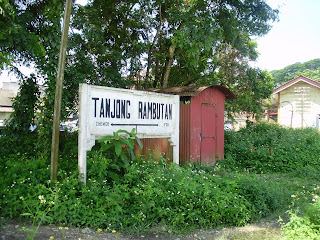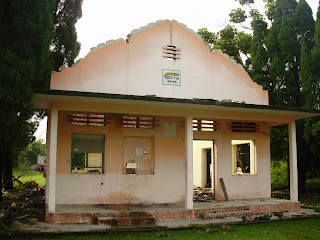Fryer Road is a very little known road which runs behind the Ipoh railway station. Not many people use that road because it is rather narrow and doesn't seem to lead to anywhere significant in town. Today, it has been renamed Persiaran Tun Perak. Just to go down memory lane, I went along that road again this morning to see if things are still the same. I remember walking along this road whenever we wanted to go to Ipoh town and also to school when I was a boy. So what did I find? First, I felt rather disappointed because the railway quarters along this road are no longer there. Next, I went looking for the turn-table - the place where they used to turn the old railway engines around because as we know, railway engines could not make a u-turn on the railway lines. That too was gone. But fortunately, after going down the road a bit further, I came across some familiar sights.

The Hindu temple is still there! It was just a small shrine during my childhood days and I can still remember hearing the sound of its bell every evening. To many of us, when we heard the sound of the bell, it meant that it was time to stop playing and to go home. Today, the shrine has bloomed into a beautiful temple and I am sure its bell still rings every evening.
The temple seems to be standing alone, looking so lonely, unlike in the past when it was surrounded by rows and rows of railway workers' quarters. We used to call those quarters Down Quarters because they were located in a valley below the level of the road. Today, there is no sign of those quarters, they have all been demolished.
I was surprised to see this sea-coconut tree next to the hindu temple. This is a very old tree and is the only one of a few left in this area along Fryer Road. There used to be so many of these trees in this place. The fruit is delicious with its jelly-like flesh.
This is the name plate of the hindu temple with a lot of information in great details.
Just next to the Hindu temple, is the prayer hall for the Sikhs. It also survived the wind of change and remains where it used to be. Of course, like the hindu temple, it has undergone some changes and has looked nice and beautiful too.
Like the hindu temple, this sikh gurdwara also has a magnificent tree by its side to give shade. It is so good to know that such trees are not chopped down in the name of development.
A few meters down the road, is another Hindu shrine. This one is relatively new and was not there during my childhood days. Nevertheless, I think a lot of art work has gone into erecting this shrine and it looks so peaceful too with those coconut trees all around it. The fact that there are so many places of worship located along this short stretch of road, reflects the rich cultural history of the people who stayed here in the past and the level of tolerance and harmony that existed at that place.

Then, I was delighted to know that our "tunnel" or the subway beneath the railway lines is still there. This is the longest subway which pedestrians can use if they want to get from Fryer Road to the Ipoh Railway station. There used to be short subways between platforms at this railway station, but they have all been filled up and closed up. Overhead bridges have been built in their place.As you can see in the picture above, there is ample parking space and the entrance to the subway is just a simple structure with no signboard at all. Those people who are unfamiliar with this place will not even know what it is if no one tells them about it. Those days, the entrance used to house a small Hainanese canteen where the best coffee and toasted bread in town were sold. Anyway, tt is good to know that although the Ipoh Railway station has undergone a lot of changes, many aspects of its heritage has been preserved.

At the end of Fryer Road, there is a junction to Jalan Tun Perak. This is another road which is rich in historical landmarks. Very near to the junction is an old railway crossing. The railway lines lead from Ipoh Railway Station to Falim station. It was a line used for shunting purposes and there was also a railway workshop in Falim. The railway line is now not used anymore, so it is slowly being overgrown with grass and weeds.
The picture above shows the home of the gatekeeper and also a small concrete structure in the foreground which was where the signal lamps (oil lamps) were kept. Both of these places are now not in use anymore.
As you can see in the picture above, these are the levers which the gatekeeper had to pull to allow the train to go on the right or left line when there is a fork at the railway lines. They are also used to control the signal lamps - red or green for the on-coming trains. This was used before they were replaced with electric ones.
As shown in the picture above, when the gatekeeper pulls the lever, the signal will fall from a horizontal position. If it is night, then the signal will be lighted with an oil lamp behind it so that when it is in horizontal position, the red plate of the signal will be lighted up, but when it falls, the green filter will be lighted up. If you see carefully you could see a ladder going up the structure, this is for the gatekeeper to climb up at night to put the oil lamps behind the signals. In this picture, the signal on the left has fallen, so the train driver knows that the gate at the level crossing is opened for the train and closed to road users. The younger generation will no longer see such signals along the railway tracks in the very near future because they have all been gradually replaced by electric lamps like those at road junctions.
At the base of these levers we can see the names of the manufacturer and the year in which it was made.
It was made in London in 1947 and was patented in 1921. Until today, it still remains solid and could still be used despite the exposure to the sun and rain.

























 r
r

